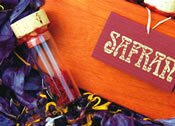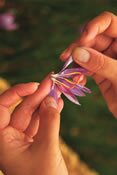Inflight Magazine of Brussels Airlines
Welcome to the Inflight Magazine of Brussels Airlines
Posh spice
As the autumn sun turns the saffron fields near Madrid purple, Heidi Fuller-love joins the locals to reap, fête and eat Spain’s poshest spice
Image photolibrary.com, Heidi Fuller-love
 Scoffed by emperors, guzzled by kings and gobbled by tsars, the ruby stigmas of the saffron plant have been prized for centuries. In that time, the spice has been the subject of countless fantasies and frauds; during the Middle Ages, for example, punishment for saffron adulterators who cut the spice with dried calendula, marigold or even urine included burning at the stake.
Scoffed by emperors, guzzled by kings and gobbled by tsars, the ruby stigmas of the saffron plant have been prized for centuries. In that time, the spice has been the subject of countless fantasies and frauds; during the Middle Ages, for example, punishment for saffron adulterators who cut the spice with dried calendula, marigold or even urine included burning at the stake.
But what is so special about saffron? One October morning, I took the Don Quixote trail, from Cervantes’ hometown of Alcalá de Henares to Spain’s saffron capital Consuegra, to find out.
From the hill above Consuegra, the lilac and lime-green stippled saffron fields stretch in every direction. The vast saffron-planted space looks as though it must be worth a fortune, until you learn that you need around 150,000 crocus flowers to make just 1kg of saffron. The world’s most expensive spice sells for about €35,000 per kilo, which is about €10,000 more than the same amount of gold. Luckily, it only takes a few strands to give that distinctive orange colour and musky, pungent flavour to everything from paella to poultry.
 Saffron only flowers for a few hours each morning and each bloom must be harvested before it withers in the sun. So the following day I’m up at the crack of dawn and following farmer Antonio Garcia to the fields to join in the vaguely quixotic job of harvesting the spice that costs more per gram than a pair of Victoria Beckham’s designer jeans.
Saffron only flowers for a few hours each morning and each bloom must be harvested before it withers in the sun. So the following day I’m up at the crack of dawn and following farmer Antonio Garcia to the fields to join in the vaguely quixotic job of harvesting the spice that costs more per gram than a pair of Victoria Beckham’s designer jeans.
The roseras (saffron harvesters) are there ahead of me, their crouched forms flitting mysteriously over the dark, red soil beneath a sea of early morning mist. There’s no machine that can strip the saffron flowers, just as there is no mechanical way to speed their harvest, so we work our way along the rows, bending from flower to purple flower, pinching each bloom from the base of plant and tossing it into our wicker baskets. By 11am, not a single splash of purple remains on this cracked sleeve of soil.
Carrying our booty back to the cosy blue and yellow tiled kitchen of the saffron farmer’s low-beamed farmhouse, we watch the village’s most skilled elders, known as mondadoras (from the Spanish word ‘mondadora’ meaning to pluck), as they begin the delicate work of cleaning and sorting.
 The air fills with heavenly odours of fresh coffee and deliciously gooey slabs of pan de Calatrava (the local version of cheesecake) as these dexterous women squeeze open each flower, pluck out three brilliant red stigmas, then cast the wilted bloom on a growing pile at their feet. According to Antonio, an experienced mondadora can strip about 1,000 flowers in an hour. Toasted over charcoal embers then dried overnight at 45°C, the fragile pistils will lose about 80% of their weight. They’ll then be graded according to their depth of colour. Coupè is held to be the best quality, followed by mancha selecto, rio and sierra.
The air fills with heavenly odours of fresh coffee and deliciously gooey slabs of pan de Calatrava (the local version of cheesecake) as these dexterous women squeeze open each flower, pluck out three brilliant red stigmas, then cast the wilted bloom on a growing pile at their feet. According to Antonio, an experienced mondadora can strip about 1,000 flowers in an hour. Toasted over charcoal embers then dried overnight at 45°C, the fragile pistils will lose about 80% of their weight. They’ll then be graded according to their depth of colour. Coupè is held to be the best quality, followed by mancha selecto, rio and sierra.
That evening, the election of Consuegra’s saffron queen in the town hall decked with saffron-coloured bunting signals the start of La Fiesta de la Rosa del Azafrán (www.aytoconsuegra.es). Dating back to the 1960s, this riotous three-day festival – which includes events in the town square such as traditional dances, saffron cookery classes and competitions to find the region’s fastest mondadora – is Consuegra’s way of marking and celebrating the end of the arduous two-week saffron harvest.
Seeking a bath to ease my aching back, though, I sneak back to my hotel, Parador de Albacete (www.parador.es), where a special saffron tasting menu by chef Martín Alonso Castaño awaits me. Better than a soak in a hot tub, the chef’s sumptuous chicken-saffron soup, followed by pungent saffron-seared sea scallops and moist saffron cake, provide the ideal comfort food – and a right royal reward for my backbreaking day in the fields harvesting the world’s poshest spice.
Saffron-based dishes
The top restaurants to visit for some truly mouthwatering meals
Madrid
El Ventorrillo Murciano (20 Calle Tres Peces, tel. ) A cosy restaurant serving squid-ink paella and other sumptuous saffron-scented dishes.
Bilbao
Etxanobe (4 Avenida de Abandoibarra, tel. ) Chef Fernando Canales serves spaghetti topped with Beluga caviar in a saffron mussel juice and other sapid dishes.
Lyon
L’Auberge du Pont de Collonges (40 Rue de la Plage, tel. ) Saffron-flavoured mussels are among the spicy delights at Paul Bocuse’s swanky Lyonnais restaurant.
The spice of life
How to make the most of saff ron
Choosing saffron
Fresh saffron strands should be a rich burgundy colour, while the powder form should be red or orange but never yellow. Get a better price and the guarantee that your saffron is 100% pure by buying from a registered producer such as Safinter (www.safinter.com).
Using saffron
Generally used in an infusion, a few threads of saffron should be soaked for 12 to 24 hours in milk, water, broth or wine, then used to create dishes ranging from paella to poultry. If you’re nervous about using this expensive spice, see www.ifood.tv/network/spanish_paella_saffron/recipes for some helpful videos.
Joining a harvest
A Taste of Spain (www.atasteofspain.com) organises saffron harvest weekends leaving from Madrid in October.
Joining a saffron fiesta
Celebrate the posh spice at these festivals
Toulouse
Sample safran de Quercy cheese and other delights at Quercy’s saffron festival (www.safran-du-quercy.com) held annually on the third weekend in October.
Rome
Inhabitants of the Umbrian town of Città della Pieve (www.cittadellapieve.org), who became saffron producers 20 years ago when Alberto Vigano planted saffron bulbs on his land, hold a spice-packed festival every year in October.
FR Épice sélect
Heidi Fuller-love se joint aux natifs pour moissonner, faire la fête et déguster l’épice la plus chic d’Espagne : le safran
Les stigmates de couleur rubis-ocre de la fleur de safran sont des ingrédients prisés depuis de nombreux siècles. Pour découvrir ce qui rend cette plante si spéciale, je me suis rendue en Espagne, à Consuegra, la capitale du safran.
Environ fleurs de crocus sont nécessaires à la fabrication d’1kg de safran. C’est l’épice la plus chère du monde à un prix tournant aux alentours de 35 000 € le kilo. Heureusement, il suffit de quelques pincées pour donner à la cuisine cette couleur orangée, si distinctive, et cet arôme musqué.
Les fleurs de safran n’éclosent que durant quelques heures chaque matin, ce qui signifie se lever aux premières lueurs de l’aube pour suivre aux champs le cultivateur Antonio Garcia. Les roseras (les cueilleurs de safran) sont déjà sur place. Aucune machine ne peut récolter les fleurs, nous devons donc nous baisser d’un plant à l’autre. De retour à la ferme, nous observons les mondadoras (du terme espagnol mondadora qui signifie ‘cueillir’), qui commencent le travail délicat de lavage et de sélection. Les femmes ouvrent ensuite chaque fleur pour en extraire les trois stigmates rouges, et elle jettent la plante qui vient s’empiler en tas à leurs pieds. D’après Antonio: “une mondadora expérimentée peut traiter environ 1 000 fleurs par heure.”
Placées au-dessus de charbon de bois brûlant, les épices sont séchées durant toute une nuit à 45°C. Ces fragiles pistils peuvent alors perdre jusqu’à 80% de leur poids. Ils sont ensuite sélectionnés selon l’intensité de leur couleur – coupè étant la meilleure qualité, suivi de mancha selecto, rio et sierra.
Ce soir-là, l’élection de la Reine du Safran de Consuegra donne le coup d’envoi à “La Fiesta de la Rosa del Azafrán” (aytoconsuegra.es), un festival exubérant de trois jours. Pour ma part, je m’éclipse pour rentrer au Parador de Albacete (parador.es), où m’attend un menu spécial dégustation de plats au safran. Le délicieux potage de poulet, les coquilles Saint-Jacques saisies à la poêle et le gâteau moelleux au safran sont de réels délices – et une somptueuse récompense pour ce dos malmené après une journée dans les champs.
NL Mag het een snuifje meer zijn?
Heidi Fuller-love oogst, eert en smult van Spanje’s favoriete specerij – saffraan
De oranjerode stempels van de saffraanplant worden al eeuwenlang geroemd. In een poging te ontdekken wat er zo speciaal is aan de plant, reisde ik naar de Spaanse saffraanhoofdstad, Consuegra.
Er zijn ongeveer 150.000 saffraankrokussen nodig om 1 kg saffraan te produceren. Het is de duurste specerij ter wereld, de prijs kan oplopen tot zo’n 35.000 euro per kilo. Gelukkig zijn er maar een paar draden nodig om voedsel die typisch oranjerode kleur en muskusachtig aroma te bezorgen.
Saffraan bloeit elke ochtend slechts enkele uren, wat wil zeggen dat ik vroeg uit de veren moet om landbouwer Antonio Garcia te volgen naar de velden. De roseras (saffraantelers) zijn er al wanneer ik aankom. Geen enkel machine kan de bloemen oogsten, dus plooien we ons dubbel voor iedere plant. Eens terug in de boerderij kijken we gefascineerd toe hoe de mondadoras (van het Spaanse woord mondadora, wat ‘plukken’ betekent) het delicate werk van schoonmaken en sorteren aanzetten. De vrouwen knijpen elke bloem open, plukken er drie rode stempels uit en gooien de bloem vervolgens bij de anderen op een hoopje aan hun voeten. Antonio vertelt: “Een ervaren mondadora kan zo’n 1000 bloemen strippen per uur”.
De stempels worden eerst geroosterd boven gloeiende houtskool en worden een nacht lang gedroogd bij 45°C. De fragiele stampers verliezen zo 80% van hun gewicht. Vervolgens worden ze gesorteerd volgens kleurintensiteit – coupè is de beste kwaliteit, voor mancha selecto, rio en sierra.
Die avond luidt de verkiezing van de Saffraankoningin van Consuegra de start in van Fiesta de la Rosa del Azafrán (aytoconsuegra.es), een uitgelaten driedaags festival.
Intussen zak ik stiekem terug af naar Parador de Albacete (parador.es) waar een speciaal saffraanmenu op me wacht. Ik proef er achtereenvolgens heerlijk geurende kippensoep met saffraan, kalfsoester geschroeid met saffraan en zachte saffraancake. Een ideaal menu om me te troosten – en een rijkelijke beloning voor mijn rugtergende werkdag op het veld.
Leave a Reply
